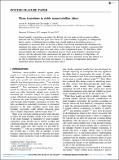Phase transitions in stable nanocrystalline alloys
Author(s)
Kalidindi, Arvind Rama; Schuh, Christopher A
DownloadMC nano phase transitions, JMR.pdf (598.7Kb)
PUBLISHER_POLICY
Publisher Policy
Article is made available in accordance with the publisher's policy and may be subject to US copyright law. Please refer to the publisher's site for terms of use.
Terms of use
Metadata
Show full item recordAbstract
Grain boundary segregation can reduce the driving force for grain growth in nanocrystalline materials and help retain fine grain sizes. However, grain boundary segregation is enthalpically driven, and so a stabilized nanocrystalline state should undergo a disordering process as temperature is increased. Here we develop a Monte Carlo-based simulation that determines the minimum free energy state of an alloy with a strong tendency for grain boundary segregation that considers both different grain sizes and a large solute configuration space. We find that a stable nanocrystalline alloy undergoes a disordering process where grain boundary segregated atoms dissolve into the adjacent grains and increase the grain size as a function of temperature. At a critical temperature, the single crystal state becomes the most preferred. Using this method, we are able to determine how the grain size changes as a function of temperature and produce equilibrium phase diagrams for nanocrystalline alloys.
Date issued
2017-06Department
Massachusetts Institute of Technology. Department of Materials Science and EngineeringJournal
Journal of Materials Research
Publisher
Cambridge University Press
Citation
Kalidindi, Arvind R. and Christopher A. Schuh. “Phase Transitions in Stable Nanocrystalline Alloys.” Journal of Materials Research 32, 11 (May 2017): 1993–2002 © 2017 Materials Research Society
Version: Author's final manuscript
ISSN
0884-2914
2044-5326